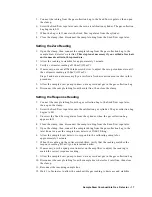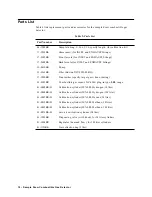
14 • Sample Draw Combustible Gas Detector
Replacing Components of the Combustible Gas
Sample Draw Detector
This section includes procedures to replace the sensor, filter, and ferrules.
Replacing the combustible gas sensor
1. Turn off incomming power.
2. Open the housing door of the sample draw detector.
3. Unscrew and remove the two screws that secure the retraining plate, then lift the
plate, connector, and sensor out of the housing.
4. Unplug the connector from the sensor.
5. Verify that you are using the correct replacement sensor (NC-6240 is printed on the
sensor), then plug the sensor into the connector.
6. Place the sensor in the combustible gas sensor cavity, then position the retaining plate
on the two standoffs.
7. Secure the retaining plate to the standoffs with the two screws you removed in step 3.
8. Turn on incomming power.
CAUTION: Allow the replacement sensor to warm up for 15 minutes before you continue.
9. Calibrate the replacement sensor as described in the “Calibration” section on page 16.
Replacing the filter
1. Open the housing door of the sample draw detector.
2. Note the direction of the arrow on the filter. The arrow indicates the direction of the
sample flow.
3. Disconnect the filter from the elbows on each end of the filter, then remove the filter
from the sample draw detector.
4. Make sure the arrow is pointing in the same direction as the arrow on the filter you
removed, then connect each end of the replacement filter to the elbows.
5. Verify that the flow rate is approximately 1.5 SCFH, then close the housing door.
Replacing the ferrules
The INLET and EXHAUST fittings each includes two ferrules that seal the incoming or
exhaust tubing to the fitting. Replace the ferrules if the seal is bad or if you replace the
sample tubing. Always replace the ferrules as a pair.
1. Disconnect the sample tubing from the fitting, then unscrew the nut from the fitting.
2. Verify that the ferrules did not remain in the nut. If necessary, remove the ferrules
from the nut.
3. Position the nut so the threaded end is facing you, then insert the bottom (smaller)
ferrule into the nut. Insert the ferrule so the flat side is facing down.
NOTE: Make sure the bottom ferrule is laying flat in the nut.
4. Insert the cone-shaped front ferrule on top of the bottom ferrule. Insert the ferrule so
the smaller end of the cone is facing up.
5. Screw the nut onto the fitting, then connect the sample tubing to the fitting. Make sure
you firmly tighten the nut with a wrench.


















